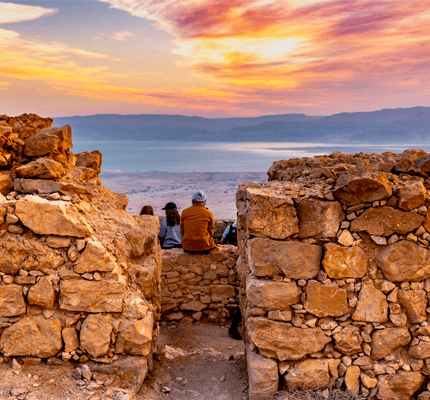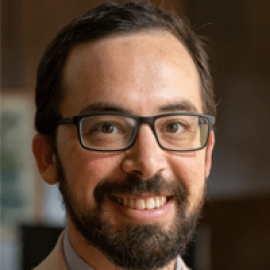
Tours at Masada as Performances
Masada is an ancient fortress that was used by a group of Jewish rebels, the Sicarii, during the Jewish-Roman War. When heavily outnumbered by the Romans, the Sicarii died by suicide, rather than be taken as slaves by the Romans. In a new article published in NCA’s Text and Performance Quarterly, Ariel Gratch examines tours as performances and analyzes the performance frames used by tour guides at Masada National Park in Israel.
Tours as Performances
Tourism in Israel is important for developing a shared identity for the Jewish community both within and outside the state of Israel. In the 20th century, tourism was used as a means of enticing immigrants to relocate to the state of Israel. However, in recent decades, Gratch argues that tourism has become more about creating a bond between tourists and Israel broadly and less about enticing immigrants. According to the article, Masada is particularly significant because “the story of Masada has been an integral part of the Jewish national myth since the [19th] century.”
Tour guides tell stories about the site and frame it for the tourists, but they may also be constrained by the tour company goals, group dynamics, and other factors. According to Gratch, “Guides at Masada are required to include boiler plate elements, but structuring their tour is largely up to them.” The guides offer their perspective on Masada, with attention to particular messages about the site. Gratch identifies four performance frames in the tours: intimate stories, activist rhetoric, ritual-like activities, and dialogue and discussion. These frames overlap at times, but often one frame may be more important than another for a particular guide. Gratch’s analysis is based on participating in and observing 60 tours.
Tour Frames
Intimate Stories
The intimate stories frame refers to “directing tourists towards the guide’s ideological vision of the site.” For example, during one tour, tour guide Yossi led a brief tour of the site and said that the group needed to wait for another tour guide to “really hear the story of Masada.” After Yossi stalled by texting and calling the other guide for about 30 minutes, the guide disappeared and returned in costume. As Gratch notes, “It was not Yossi, but it was not not Yossi. Dressed in linen pants and shirt, a rope belt, and a sicar (the long bent knife used by the Sicarii of Masada), Yossi introduced himself as Elazar ben Yair, leader of the rebels at Masada.” In character, Yossi told the story of the experience at Masada and the ways in which the doomed group worked together to defend themselves from the Romans.
Yossi then revealed a personal connection to the site. Yossi briefly considered jail time over conscription into the Israeli army, but an experience at Masada changed that: “Alone at the top, just before sunrise, Yossi receives a vision of the events on Masada. He finds himself surrounded by the ghosts of his ancestors, watching the siege take place, the wall fall, and the Jews take their own lives rather than be condemned to a life of slavery.” Gratch argues that Yossi’s performance offered an ideological vision of the site by offering an intimate narrative of past, present, and future connections to Masada.
Activist Rhetoric
When guides use the activist rhetoric frame, they are “moving tourists to act” by offering political interpretations of sites that may influence tourists’ views. In one tour, the guide described the events at Masada and related them to current events. After finishing the historical narrative, “Omer picks up a rock and places it in front of him. ‘You see, this is Masada.’ He then places other rocks in a circle around the center rock. ‘And you see, here are the Roman camps. The Jews at Masada were surrounded. They had no choice! Now, we have today.’ He points to the center rock. ‘This is Israel. And here we have Lebanon, Syria, Jordan, Egypt. And I ask, can we let Iran get a nuclear weapon?’” Gratch argues that Omer drew connections between the past and the present to support Israeli and Zionist arguments about conflicts in the Middle East that suggest “just as Masada was surrounded by enemies, so too is the Jewish state. In this view, preemptive strikes and aggressive responses to actual violence are necessary for survival.”
Ritual-like Activities
Guides engage in ritual-like activities when “inspiring tourists to remain culturally connected to the site.” In one example, after morning prayers at the site, the tour guide described the story of Yigael Yadin, the archaeologist who excavated Masada. Yadin was a secular Jew, but prayed with a younger individual who had recounted surviving a gulag where they were punished for practicing Judaism. While praying, Yadin donned the tefillin, which is worn on the arm and the head. After the prayer, a woman who observed them praying revealed how much it meant that Yadin wore the tefillin and recounted a story about her husband who had died in battle. Moved by the story, Yadin told the woman about a recent discovery of a 2,000-year-old pair of tefillin. Gratch argues that the guide set the tone for the day by recounting this story and explaining the meaning of tefillin: “The story teaches the group that, even though they are witnessing a site that was important for a specific point in history, the traditions from that history are still important today. While their individuality helps make them who they are, there is something deeper, more important than the self.”
Dialogue and Discussion
Through dialogue and discussion, guides are “compelling tourists to critically assess their relationship to the site.” For this frame, Gratch draws on an experience with an LGBTQ+ Birthright Israel group. These tours bring young Jewish people to Israel for free to experience the country; the LGBTQ+ tours are specifically geared toward Jewish members of those communities. In this case, the tour guide offered three stories about Masada. First, the guide told the story of the Sicarii who resisted Roman rule. Second, the guide described the story of Yohanan ben Zakai, a rabbi whose followers studied the Torah within the Roman empire, despite constrictions imposed by the Jewish-Roman war. The third story was that of the historian of Masada, Josephus Flavius, who lived among the Romans. The participants connected these stories with their own experiences of oppression as LGBTQ+ individuals in the United States and engaged in a complex discussion about their lives.
Conclusion
This article examined how tour guides use frames at Masada to influence tourists. Gratch argues that each frame offers different advantages to the tour guide and that understanding tours as performances can “help us see the site in a new light.”


